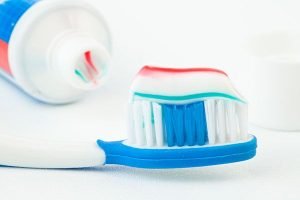 Fluoride is a mineral that occurs naturally in water and many foods (e.g. spinach, potatoes, peas, fish, pork).
Fluoride is a mineral that occurs naturally in water and many foods (e.g. spinach, potatoes, peas, fish, pork).
Every day, minerals are added to and lost from a tooth’s enamel layer through two processes, demineralization and remineralization.
Minerals are lost (demineralization) from a tooth’s enamel layer when acids — formed from plaque bacteria and sugars in the mouth — attack the enamel. Minerals such as fluoride, calcium, and phosphate are redeposited (remineralization) to the enamel layer from the foods and waters consumed.
Too much demineralization without enough remineralization to repair the enamel layer leads to tooth decay.
Fluoride helps prevent tooth decay by making the tooth more resistant to acid attacks from plaque bacteria and sugars in the mouth. It also reverses early decay.
In children under six years of age, fluoride becomes incorporated into the development of permanent teeth, making it difficult for acids to demineralize the teeth. Fluoride also helps speed remineralization as well as disrupting acid production in already erupted teeth of both children and adults.
In What Forms Is Fluoride Available?
As mentioned, fluoride is found in foods and in water. It can also be directly applied to the teeth through fluoridated toothpastes and mouth rinses. A dentist or hygienist in his or her surgery can also apply fluoride to the teeth as a gel, foam, or varnish.
These treatments contain a much higher level of fluoride than the amount found in toothpastes and mouth rinses.
Varnishes are painted on the teeth; foams are put into a mouth guard, which is applied to the teeth for 1 to 5 minutes; gels can be painted on or applied via a mouth guard.
When Is Fluoride Intake Most Critical?
It is certainly important for infants and children between the ages of 6 months and 16 years to be exposed to fluoride. This is the timeframe during which the primary and permanent teeth come in. However, adults benefit greatly from fluoride too.
New research indicates that topical fluoride — from toothpastes, mouth rinses, and fluoride treatments — are as important in fighting tooth decay as in strengthening developing teeth.
In addition, people with certain conditions may be at increased risk of tooth decay and would therefore benefit from additional fluoride treatment.
They include people with:
- Dry mouth conditions : Dry mouth caused by diseases such as Sjögren’s syndrome, certain medications (such as allergy medications, antihistamines, anti-anxiety drugs, and high blood pressure drugs), and head and neck radiation treatment makes an individual more prone to tooth decay. The lack of saliva makes it harder for food particles to be washed away and acids to be neutralized.
- Gum disease : Also called gingivitis and periodontitis. Gum disease can expose more of your tooth and tooth roots to bacteria increasing the chance of tooth decay.
- History of frequent cavities : If you have one cavity every year or every other year, you might benefit from additional fluoride.
- Presence of crowns large fillings and/or bridges or braces : These treatments can put teeth at risk for decay at the point where the crown meets the underlying tooth structure or around the brackets of orthodontic appliances.
Ask your dentist if you could benefit from additional fluoride.
Are There Risks Associated With Fluoride Use?
Fluoride is safe and effective when used as directed but like almost anything it can be hazardous at high doses (the “toxic” dosage level varies based on an individual’s weight).
For this reason, it’s important for parents to carefully supervise their children’s use of fluoride-containing products and to keep fluoride products out of reach of children, especially children under the age of 6.
In addition, excess fluoride can cause defects in the tooth’s enamel that range from barely noticeable white specks or streaks to cosmetically objectionable brown discoloration. These defects are known as fluorosis and occur when the teeth are forming — usually in children under 6 years.
Fluorosis, when it occurs, is usually associated with naturally occurring fluoride, such as that found in well water. If you use well water and are uncertain about the mineral (especially fluoride) content, a water sample should be tested.
Keep in mind, however, that it’s very difficult to reach hazardous levels given the low levels of fluoride in home-based fluoride-containing products. Nonetheless, if you do have concerns or questions about the amount of fluoride you or your child may be receiving, talk to your child’s dentist, pediatrician, or family doctor.
A few useful reminders about fluoride include:
- Store fluoride supplements away from young children.
- Avoid flavored toothpastes because these tend to encourage toothpaste to be swallowed.
- Use only a pea-sized amount of fluoridated toothpaste on a child’s toothbrush.
- Use a low level fluoride toothpaste for children under age 6. Children under 6 years of age are more likely to swallow toothpaste instead of spitting it out.
Call us on (03) 5472 1377 or book your appointment online today.


